Exploring the Transcriptome Dynamics of In Vivo Theileria annulata Infection in Crossbred Cattle
Abstract
:1. Introduction
2. Materials and Methods
2.1. Samples
2.2. Microscopic Examination
2.3. Molecular Detection of Haemoparasite in Blood
2.4. RNA Isolation and Sequencing
2.5. Data Analysis
2.6. Validation by Real-Time Quantitative PCR (RT qPCR)
3. Results
3.1. Summary of RNA Seq Data
3.2. Gene Expression Profile
3.3. Validation of RNAseq Data by RT-qPCR
3.4. Differentially Expressed Genes and Enriched Pathways
3.5. Gene–Protein Interactions
4. Discussion
5. Conclusions
Supplementary Materials
Author Contributions
Funding
Data Availability Statement
Acknowledgments
Conflicts of Interest
References
- BAHS. Basic Animal Husbandry Statistics; Department of Animal Husbandry Dairying and Fisheries, Government of India, Ministry of Agriculture and Farmers’ Welfare: New Delhi, India, 2019; pp. 1–132. [Google Scholar]
- Kumar, S.; Mohmad, A.; Parthasarathi, B.C.; Fular, A.; Gupta, S.; Singh, D. Current epidemiological status of bovine theileriosis in Indian scenario. Ann. Clin. Cytol. Pathol. 2018, 4, 1090. [Google Scholar]
- Shiels, B.; Langsley, G.; Weir, W.; Pain, A.; McKellar, S.; Dobbelaere, D. Alteration of host cell phenotype by Theileria annulata and Theileria parva: Mining for manipulators in the parasite genomes. Int. J. Parasitol. 2006, 36, 9–21. [Google Scholar] [CrossRef]
- Kumar, A.; Gaur, G.K.; Gandham, R.K.; Panigrahi, M.; Ghosh, S.; Saravanan, B.; Bhushan, B.; Tiwari, A.K.; Sulabh, S.; Priya, B.; et al. Global gene expression profile of peripheral blood mononuclear cells challenged with Theileria annulata in crossbred and indigenous cattle. Infect. Genet. Evol. 2017, 47, 9–18. [Google Scholar] [CrossRef]
- Larcombe, S.D.; Kolte, S.W.; Ponnudurai, G.; Kurkure, N.; Magar, S.; Velusamy, R.; Rani, N.; Rubinibala, B.; Rekha, B.; Alagesan, A.; et al. The impact of tick-borne pathogen infection in Indian bovines is determined by host type but not the genotype of Theileria annulata. Infect. Genet. Evol. 2019, 75, 103972. [Google Scholar] [CrossRef]
- Jensen, K.; Paxton, E.; Waddington, D.; Talbot, R.; Darghouth, M.A.; Glass, E.J. Differences in the transcriptional responses induced by Theileria annulata infection in bovine monocytes derived from resistant and susceptible cattle breeds. Int. J. Parasitol. 2008, 38, 313–325. [Google Scholar] [CrossRef]
- Soulsby, E.J.L. Helminths, Arthropods and Protozoa of Domesticated Animals, 7th ed.; The English Language Book Society and Baillere, Tindall and Cassel: London, UK, 1982; p. 809. [Google Scholar]
- Ganguly, A.; Maharana, B.R.; Ganguly, I. Pentaplex PCR assay for rapid differential detection of Babesia bigemina, Theileria annulata, Anaplasma marginale and Trypanosoma evansi in cattle. Biologicals 2020, 63, 81–88. [Google Scholar] [CrossRef]
- Andrews, S. FastQC: A Quality Control Tool for High Throughput Sequence Data. 2010. Available online: https://www.bioinformatics.babraham.ac.uk/projects/fastqc (accessed on 1 December 2022).
- Oliveros, J.C. An Interactive Tool for Comparing Lists with Venn’s Diagrams. 2007–2015, Venny. Available online: https://bioinfogp.cnb.csic.es/tools/venny/index.html (accessed on 1 December 2022).
- Huang, D.W.; Sherman, B.T.; Lempicki, R.A. Bioinformatics enrichment tools: Paths toward the comprehensive functional analysis of large gene lists. Nucleic Acids Res. 2009, 37, 1–13. [Google Scholar] [CrossRef]
- Huang, D.W.; Sherman, B.T.; Lempicki, R.A. Systematic and integrative analysis of large gene lists using DAVID Bioinformatics Resources. Nat. Protoc. 2009, 4, 44–57. [Google Scholar] [CrossRef]
- Jassal, A.; Matthews, L.; Viteri, G.; Gong, C.; Lorente, P.; Fabregat, A.; Sidiropoulos, K.; Cook, J.; Gillespie, M.; Haw, R.; et al. The reactome pathway knowledgebase. Nucleic Acids Res. 2020, 8, D498–D503. [Google Scholar] [CrossRef]
- Kamburov, A.; Pentchev, K.; Galicka, H.; Wierling, C.; Lehrach, H.; Herwig, R. ConsensusPathDB: Toward a more complete picture of cell biology. Nucleic Acids Res. 2011, 39, 712–717. [Google Scholar] [CrossRef]
- Kamburov, A.; Wierling, C.; Lehrach, H.; Herwig, R. ConsensusPathDB—A database for integrating human functional interaction networks. Nucleic Acids Res. 2009, 37, D623–D628. [Google Scholar] [CrossRef]
- Shannon, P.; Markiel, A.; Ozier, O.; Baliga, N.S.; Wang, J.T.; Ramage, D.; Amin, N.; Schwikowski, B.; Ideker, T. Cytoscape: A software environment for integrated models of biomolecular interaction networks. Genom. Res. 2003, 13, 2498–2504. [Google Scholar] [CrossRef] [PubMed]
- Chin, C.H.; Chen, S.H.; Wu, H.H.; Ho, C.W.; Ko, M.T.; Lin, C.-Y. cytoHubba: Identifying hub objects and sub-networks from complex interactome. BMC Syst. Biol. 2014, 8, S11. [Google Scholar] [CrossRef] [PubMed]
- Untergasser, A.; Cutcutache, I.; Koressaar, T.; Ye, J.; Faircloth, B.C.; Remm, M.; Rozen, S.G. Primer3-new capabilities and interfaces. Nucleic Acids Res. 2012, 40, 115. [Google Scholar] [CrossRef] [PubMed]
- Livak, K.J.; Schmittgen, T.D. Analysis of relative gene expression data using real-time quantitative PCR and the 2(-Delta Delta C(T)) Method. Methods 2001, 25, 402–408. [Google Scholar] [CrossRef]
- Ahmed, J.S.; Glass, E.J.; Salih, D.A.; Seitzer, U. Innate immunity to tropical theileriosis. Innate Immun. 2008, 14, 5–12. [Google Scholar] [CrossRef] [PubMed]
- Thery, F.; Eggermont, D.; Impens, F. Proteomics mapping of the ISGylation landscape in innate immunity. Front. Immunol. 2021, 10, 720765. [Google Scholar] [CrossRef] [PubMed]
- Bhushan, J.; Radke, J.B.; Perng, Y.C.; Mcallaster, M.; Lenschow, D.J.; Virgin, H.W.; Sibley, L.D. ISG15 connects autophagy and IFN-γ-dependent control of Toxoplasma gondii infection in human cells. MBio 2020, 11, e00852-20. [Google Scholar] [CrossRef]
- Oura, C.A.; McKellar, S.; Swan, D.G.; Okan, E.; Shiels, B.R. Infection of bovine cells by the protozoan parasite Theileria annulata modulates expression of the ISGylation system. Cell. Microbiol. 2006, 8, 276–288. [Google Scholar] [CrossRef]
- Korpetinou, A.; Skandalis, S.S.; Labropoulou, V.T.; Esmirlaki, G.; Enoulas, A.; Karamanos, N.K.; Theocharis, A.D. Serglycin: At the crossroad of inflammation and malignancy. Front. Oncol. 2014, 3, 327. [Google Scholar] [CrossRef]
- Guo, Z.; González, J.F.; Hernandez, J.N.; McNeilly, T.N.; Corripio-Miyar, Y.; Frew, D.; Morrison, T.; Yu, P.; Li, R.W. Possible mechanisms of host resistance to Haemonchus contortus infection in sheep breeds native to the Canary Islands. Sci. Rep. 2016, 6, 26200. [Google Scholar] [CrossRef]
- Moreira, A.C.; Mesquita, G.; Gomes, M.S. Ferritin: An inflammatory player keeping iron at the core of pathogen-host interactions. Microorganisms 2020, 18, 589. [Google Scholar] [CrossRef] [PubMed]
- Chen, Y.; Tong, Y.; Li, Y.; Liu, R.; Xu, Q.; Chang, G.; Chen, G. Ferritin heavy polypeptide 1 mediates apoptosis-related gene expression of duck (Anas platyrhynchos domesticus). Can. J. Anim. Sci. 2016, 96, 619–625. [Google Scholar] [CrossRef]
- Hou, F.; Wang, L.; Wang, H.; Gu, J.; Li, M.; Zhang, J.; Ling, X.; Gao, X.; Luo, C. Elevated gene expression of S100A12 is correlated with the predominant clinical inflammatory factors in patients with bacterial pneumonia. Mol. Med. Rep. 2015, 11, 4345–4352. [Google Scholar] [CrossRef] [PubMed]
- Realegeno, S.; Kelly-Scumpia, K.M.; Dang, A.T.; Lu, J.; Teles, R.; Liu, P.T.; Schenk, M.; Lee, E.Y.; Schmidt, N.W.; Wong, G.C.L.; et al. S100A12 is part of the antimicrobial network against Mycobacterium leprae in human macrophages. PLoS Pathog. 2016, 12, 1005705. [Google Scholar] [CrossRef]
- Patrinostro, X.; Roy, P.; Lindsay, A.; Chamberlain, C.M.; Sundby, L.J.; Starker, C.G.; Voytas, D.F.; Ervasti, J.M.; Perrin, B.J. Essential nucleotide- and protein-dependent functions of Actb/β-actin. Proc. Natl. Acad. Sci. USA 2018, 115, 7973–7978. [Google Scholar] [CrossRef]
- Martinez, P.; Blasco, M.A. Telomere-driven diseases and telomere-targeting therapies. J. Cell Biol. 2017, 216, 875–887. [Google Scholar] [CrossRef]
- Ritz, U.; Seliger, B. The transporter associated with antigen processing (TAP): Structural integrity, expression, function, and its clinical relevance. Mol. Med. 2001, 7, 149–158. [Google Scholar] [CrossRef]
- Liu, H.; Zhu, T.; Li, Q.; Xiong, X.; Wang, J.; Zhu, X.; Zhou, X.; Zhang, L.; Zhu, Y.; Peng, Y.; et al. TRIM25 upregulation by Mycobacterium tuberculosis infection promotes intracellular survival of M.tb in RAW264.7 cells. Microb. Pathog. 2020, 148, 104456. [Google Scholar] [CrossRef]
- Guttery, D.S.; Ferguson, D.J.; Poulin, B.; Xu, Z.; Straschil, U.; Klop, O.; Solyakov, L.; Sandrini, S.M.; Brady, D.; Nieduszynski, C.A.; et al. A putative homologue of CDC20/CDH1 in the malaria parasite is essential for male gamete development. PLoS Pathog. 2012, 8, 1002554. [Google Scholar] [CrossRef]
- Mackiewicz, M.; Seitzer, U.; Ahmed, J.S.; Reiling, N. Theileria annulata surface protein (TaSP) is a target of cyclin-dependent kinase 1 phosphorylation in Theileria annulata-infected cells. Transbound. Emerg. Dis. 2020, 67, 40–55. [Google Scholar] [CrossRef] [PubMed]
- Zhu, Q.; Ding, L.; Zi, Z.; Gao, S.; Wang, C.; Wang, Y.; Zhu, C.; Yuan, Z.; Wei, F.; Cai, Q. Viral-mediated AURKB cleavage promotes cell segregation and tumorigenesis. Cell Rep. 2019, 26, 3657–3671. [Google Scholar] [CrossRef] [PubMed]
- Von Schubert, C.; Xue, G.; Schmuckli-Maurer, J.; Woods, K.L.; Nigg, E.A.; Dobbelaere, D.A.E. The transforming parasite Theileria co-opts host cell mitotic and central spindles to persist in continuously dividing cells. PLoS Biol. 2010, 8, 1000499. [Google Scholar] [CrossRef] [PubMed]
- Reininger, L.; Wilkes, J.M.; Bourgade, H.; Miranda-Saavedra, D.; Doerig, C. An essential Aurora-related kinase transiently associates with spindle pole bodies during Plasmodium falciparum erythrocytic schizogony. Mol. Microbiol. 2011, 79, 205–221. [Google Scholar] [CrossRef]
- Ciferri, C.; Musacchio, A.; Petrovic, A. The Ndc80 complex: Hub of kinetochore activity. FEBS Lett. 2007, 581, 2862–2869. [Google Scholar] [CrossRef]
- Chen, D.; Feng, Z.; Zhou, M.; Ren, Z.; Zhang, F.; Li, Y. Bioinformatic evidence reveals that cell cycle correlated genes drive the communication between tumor cells and the tumor microenvironment and impact the outcomes of hepatocellular carcinoma. Biomed Res. Int. 2021, 26, 4092635. [Google Scholar] [CrossRef]
- Huang, R.; Liu, J.; Li, H.; Zheng, L.; Jin, H.; Zhang, Y.; Ma, W.; Su, J.; Wang, M.; Yang, K. Identification of hub genes and their correlation with immune infiltration cells in hepatocellular carcinoma based on GEO and TCGA Databases. Front. Genet. 2021, 12, 647353. [Google Scholar] [CrossRef]
- Scholzen, T.; Gerdes, J. The Ki-67 protein: From the known and the unknown. J. Cell Physiol. 2000, 182, 311–322. [Google Scholar] [CrossRef]
- Woods, K.; Perry, C.; Brühlmann, F.; Olias, P. Theileria’s strategies and effector mechanisms for host cell transformation: From invasion to immortalization. Front. Cell Dev. Biol. 2021, 9, 662805. [Google Scholar] [CrossRef]
- Hoeksema, M.; van Eijk, M.; Haagsman, H.P.; Hartshorn, K.L. Histones as mediators of host defense, inflammation and thrombosis. Future Microbiol. 2016, 11, 441–453. [Google Scholar] [CrossRef]
- Chapman, E.A.; Lyon, M.; Simpson, D.; Mason, D.; Beynon, R.J.; Moots, R.J.; Wright, H.L. Caught in a Trap? Proteomic analysis of Neutrophil Extracellular Traps in Rheumatoid Arthritis and Systemic Lupus Erythematosus. Front. Immunol. 2019, 11, 423. [Google Scholar] [CrossRef]
- Niedzwiedzka-Rystwej, P.; Repka, W.; Tokarz-Deptuła, B.; Deptuła, W. In sickness and in health—how neutrophil extracellular trap (NET) works in infections, selected diseases and pregnancy. J. Inflamm. 2019, 16, 15. [Google Scholar] [CrossRef]
- Parrini, M.; Meissl, K.; Ola, M.J.; Lederer, T.; Puga, A.; Wienerroither, S.; Kovarik, P.; Decker, T.; Muller, M.; Strobl, B. The C-terminal Transactivation Domain of STAT1 has a gene-specific role in transactivation and cofactor recruitment. Front. Immunol. 2018, 6, 2879. [Google Scholar] [CrossRef] [PubMed]
- Mekonnen, Y.A.; Gultas, M.; Effa, K.; Hanotte, O.; Schmitt, A.O. Identification of candidate signature genes and key regulators associated with trypanotolerance in the Sheko breed. Front. Genet. 2019, 14, 1095. [Google Scholar] [CrossRef] [PubMed]
- Qiu, L.; Joazeiro, C.; Fang, N.; Wang, H.Y.; Elly, C.; Altman, Y.; Fang, D.; Hunter, T.; Liu, Y.-C. Recognition and ubiquitination of Notch by Itch, a hect-type E3 ubiquitin ligase. J. Biol. Chem. 2000, 275, 35734–35737. [Google Scholar] [CrossRef] [PubMed]
- Allen Reish, H.E.; Standaert, D.G. Role of α-synuclein in inducing innate and adaptive immunity in Parkinson disease. J. Park. Dis. 2015, 5, 1–19. [Google Scholar] [CrossRef]
- Sudhof, T.C.; Rothman, J.E. Membrane fusion: Grappling with SNARE and SM proteins. Science 2009, 323, 474–477. [Google Scholar] [CrossRef]
- Shukla, A.; Berglund, L.; Nielsen, L.P.; Nielsen, S.; Hoffmann, H.J.; Dahl, R. Regulated exocytosis in immune function: Are SNARE-proteins involved? Respir. Med. 2000, 94, 10–17. [Google Scholar] [CrossRef] [PubMed]
- Livingstone, I.; Uversky, V.N.; Furniss, D.; Wiberg, A. The Pathophysiological significance of Fibulin-3. Biomolecules 2020, 10, 1294. [Google Scholar] [CrossRef]
- Garrod, D.; Chidgey, M. Desmosome structure, composition and function. Biochim. Biophys. Acta BBA Biomembr. 2008, 1778, 572–587. [Google Scholar] [CrossRef]
- Zuma, A.A.; de Souza, W. Histone deacetylases as targets for antitrypanosomal drugs. Future Sci. OA 2018, 4, FSO325. [Google Scholar] [CrossRef] [PubMed]
- Roger, T.; Lugrin, J.; Le Roy, D.; Goy, G.; Mombelli, M.; Koessler, T.; Ding, X.C.; Chanson, A.-L.; Reymond, M.K.; Miconnet, I.; et al. Histone deacetylase inhibitors impair innate immune responses to Toll-like receptor agonists and to infection. Blood 2011, 117, 1205–1217. [Google Scholar] [CrossRef] [PubMed]
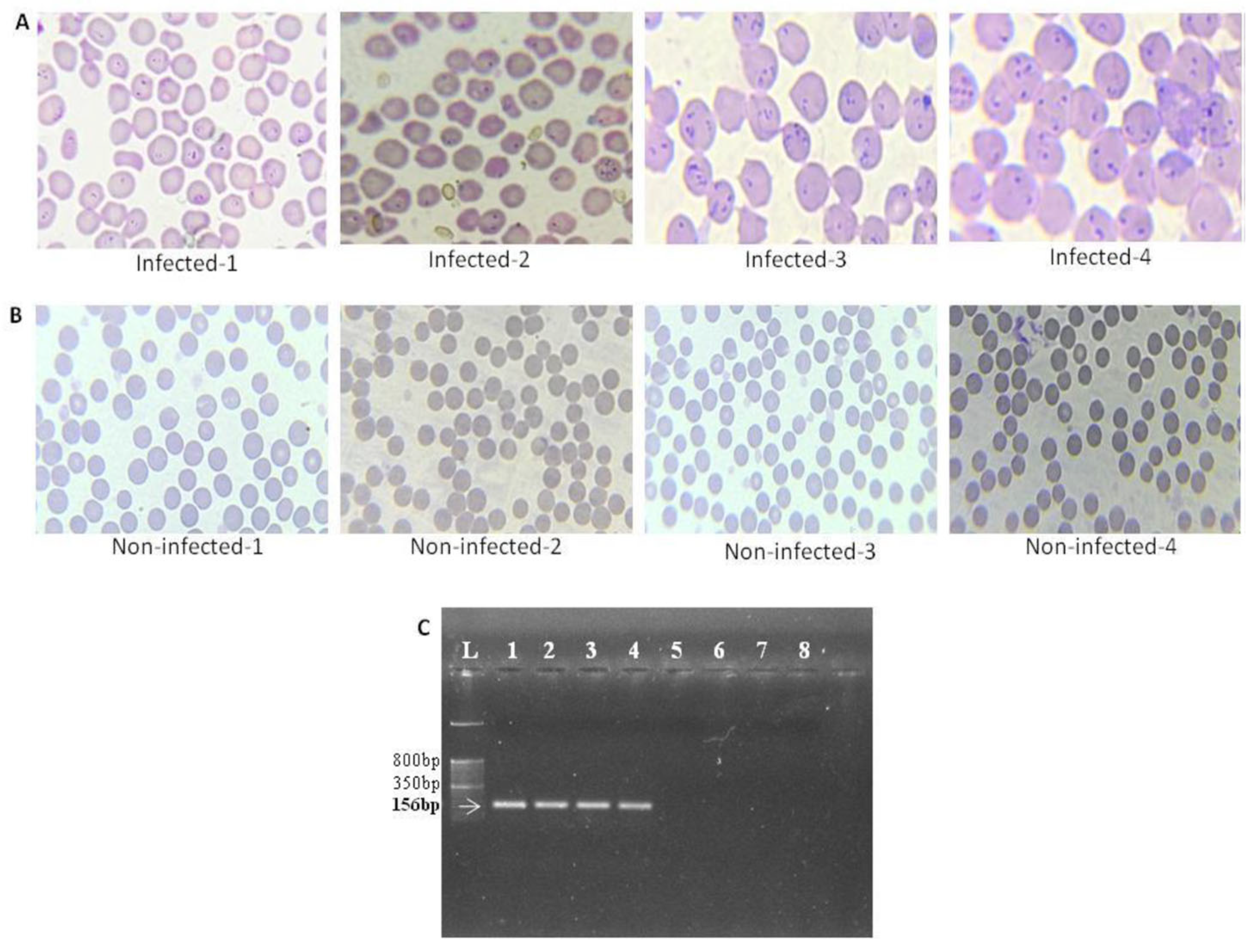
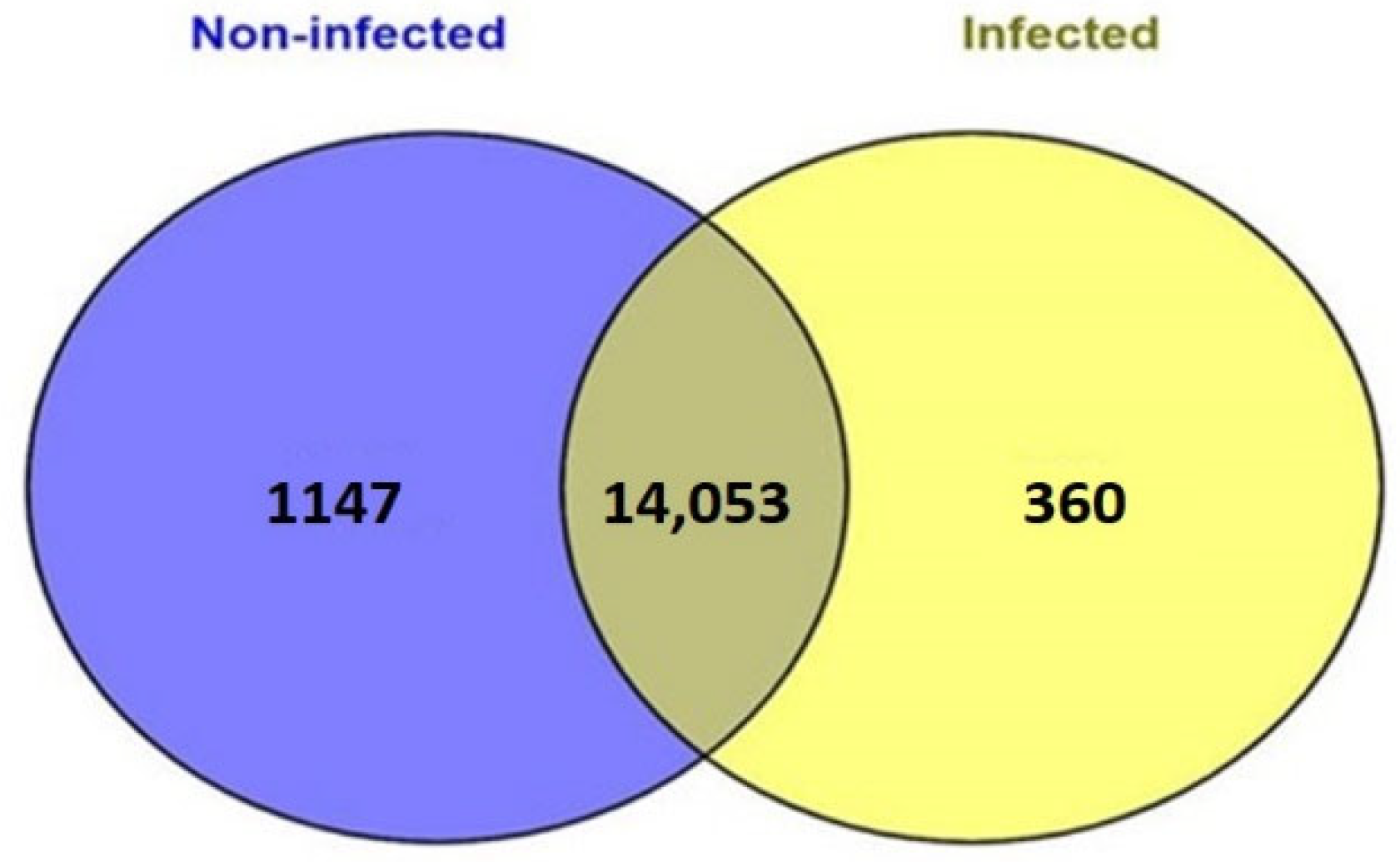
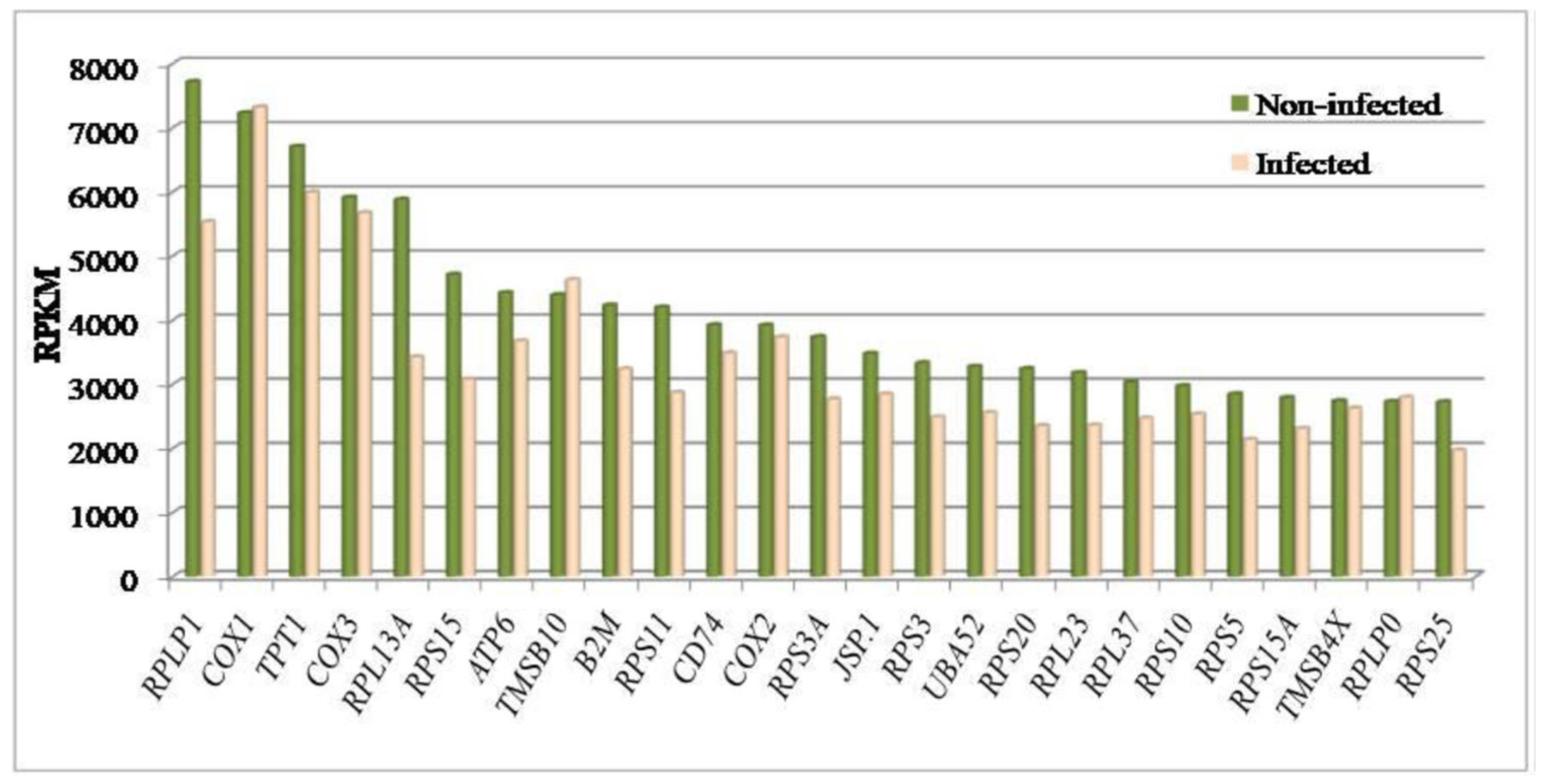
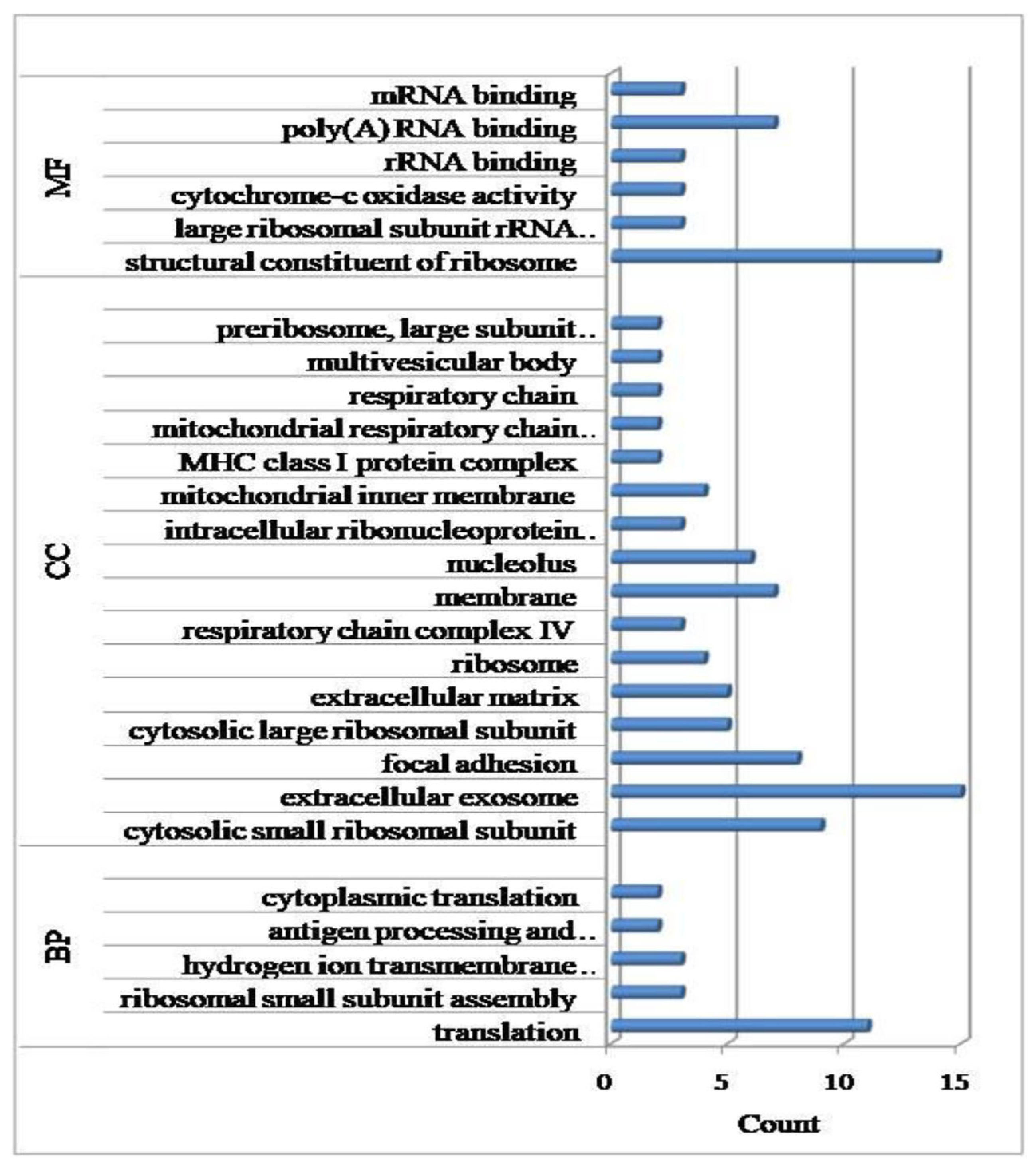
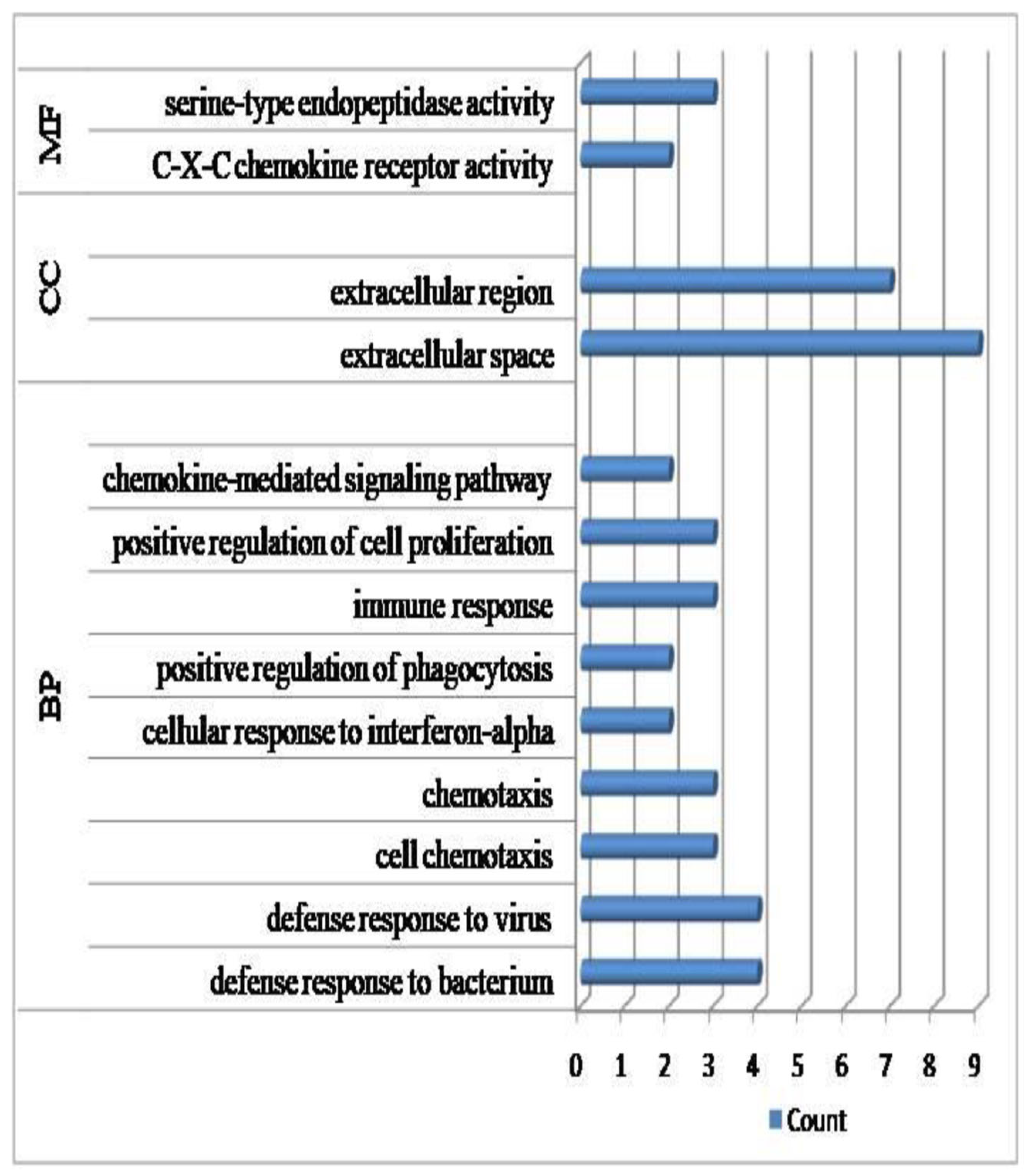
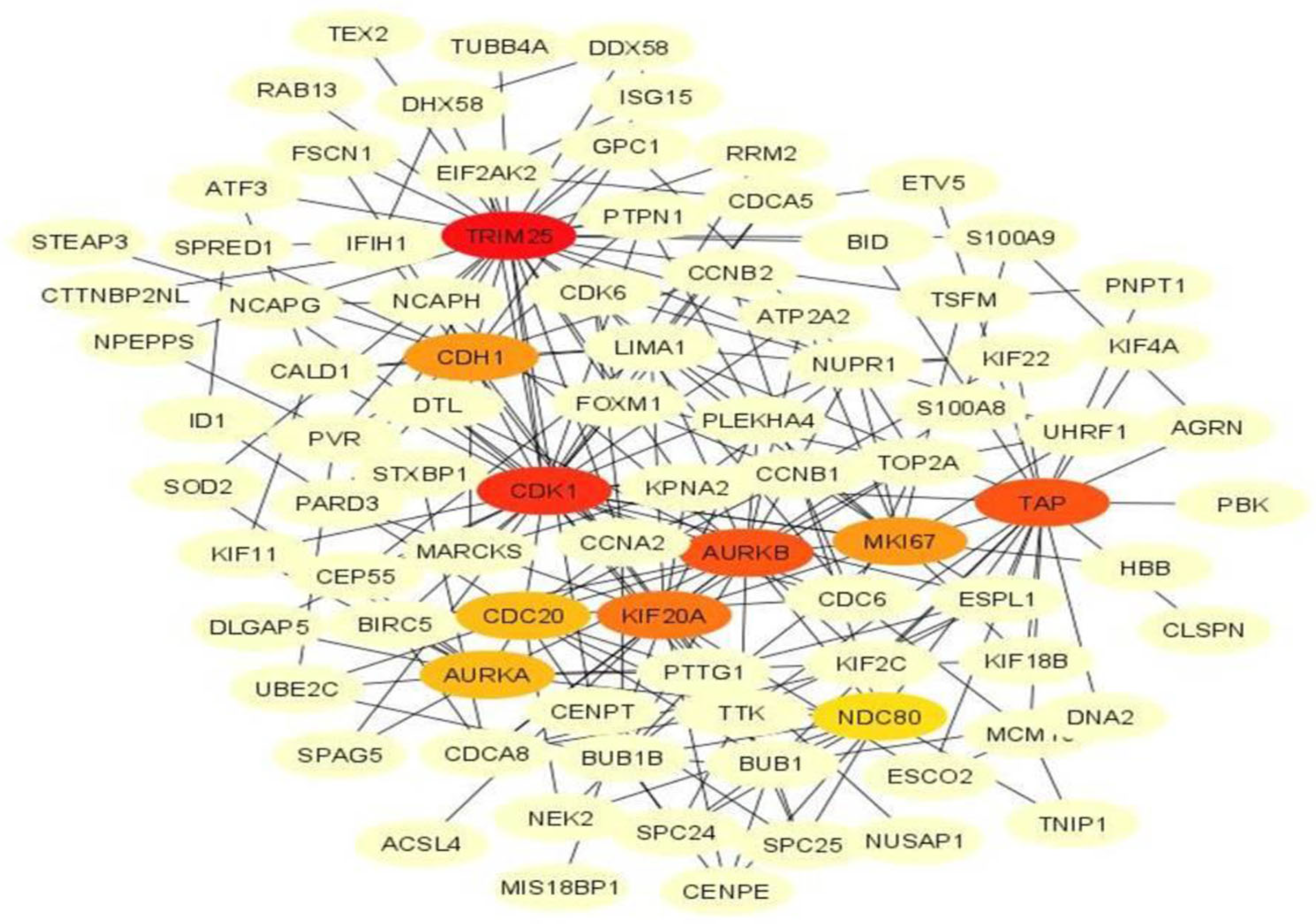

| Crossbred Cattle Sample | Raw Reads | Processed Reads | Mapped Reads | Mapping % |
|---|---|---|---|---|
| Non-infected-1 | 67,187,256 | 66,822,938 | 65,686,885 | 98.30% |
| Non-infected-2 | 78,767,458 | 78,725,278 | 76,814,152 | 97.57% |
| Non-infected-3 | 86,213,224 | 86,172,538 | 84,479,731 | 98.04% |
| Non-infected-4 | 89,485,542 | 89,167,234 | 88,175,002 | 98.89% |
| Infected-1 | 84,605,308 | 84,572,394 | 80,296,629 | 94.94% |
| Infected-2 | 81,213,906 | 81,200,906 | 80,016,469 | 98.53% |
| Infected-3 | 79,494,742 | 79,400,742 | 78,529,749 | 98.79% |
| Infected-4 | 86,943,534 | 86,910,534 | 85,711,712 | 98.58% |
Disclaimer/Publisher’s Note: The statements, opinions and data contained in all publications are solely those of the individual author(s) and contributor(s) and not of MDPI and/or the editor(s). MDPI and/or the editor(s) disclaim responsibility for any injury to people or property resulting from any ideas, methods, instructions or products referred to in the content. |
© 2023 by the authors. Licensee MDPI, Basel, Switzerland. This article is an open access article distributed under the terms and conditions of the Creative Commons Attribution (CC BY) license (https://creativecommons.org/licenses/by/4.0/).
Share and Cite
Ahlawat, S.; Choudhary, V.; Arora, R.; Kumar, A.; Kaur, M.; Chhabra, P. Exploring the Transcriptome Dynamics of In Vivo Theileria annulata Infection in Crossbred Cattle. Genes 2023, 14, 1663. https://doi.org/10.3390/genes14091663
Ahlawat S, Choudhary V, Arora R, Kumar A, Kaur M, Chhabra P. Exploring the Transcriptome Dynamics of In Vivo Theileria annulata Infection in Crossbred Cattle. Genes. 2023; 14(9):1663. https://doi.org/10.3390/genes14091663
Chicago/Turabian StyleAhlawat, Sonika, Vikas Choudhary, Reena Arora, Ashish Kumar, Mandeep Kaur, and Pooja Chhabra. 2023. "Exploring the Transcriptome Dynamics of In Vivo Theileria annulata Infection in Crossbred Cattle" Genes 14, no. 9: 1663. https://doi.org/10.3390/genes14091663
APA StyleAhlawat, S., Choudhary, V., Arora, R., Kumar, A., Kaur, M., & Chhabra, P. (2023). Exploring the Transcriptome Dynamics of In Vivo Theileria annulata Infection in Crossbred Cattle. Genes, 14(9), 1663. https://doi.org/10.3390/genes14091663





